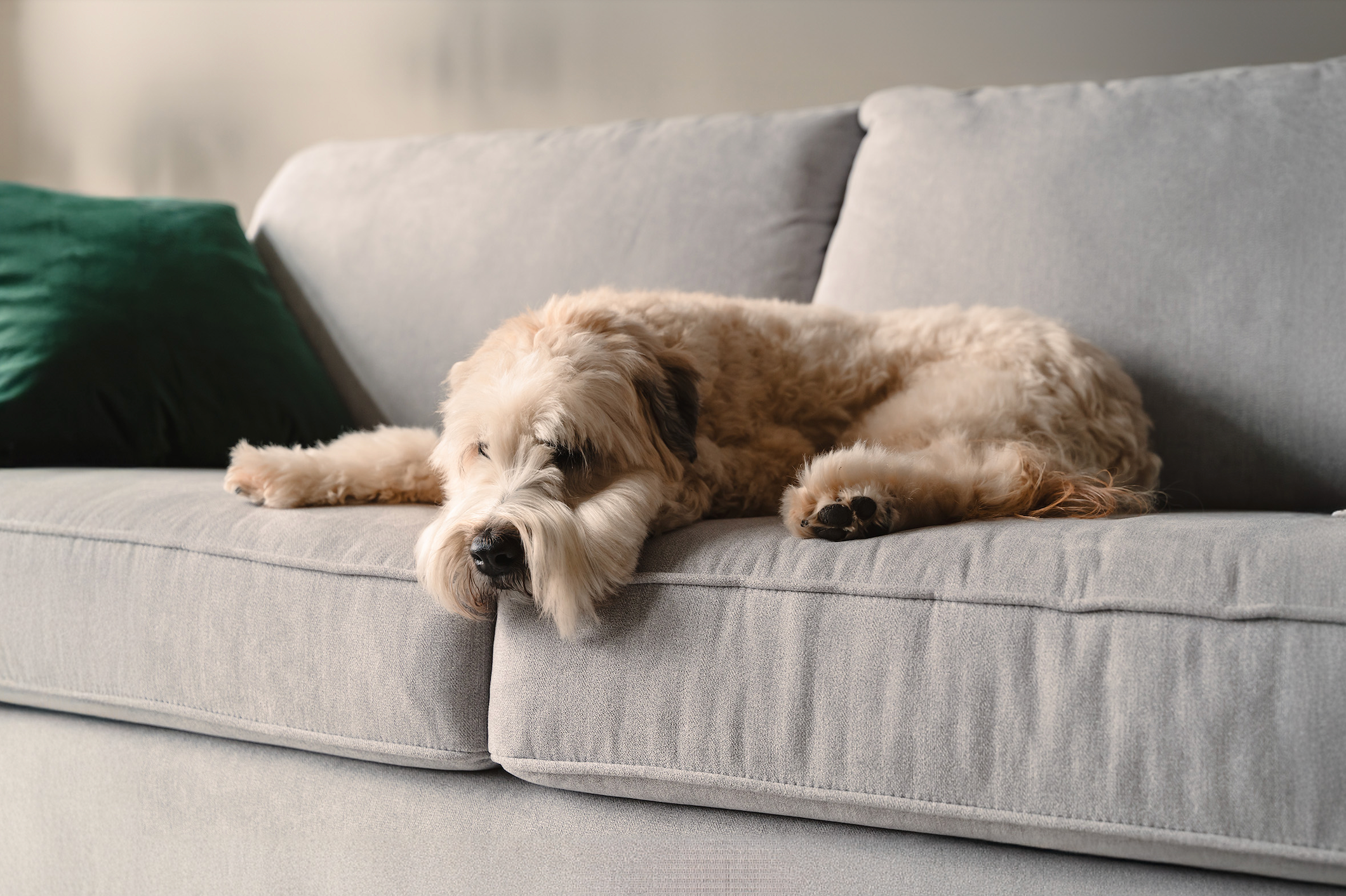Dogs, like us humans, are social creatures. They’re pack animals who have evolved over thousands of years to live alongside us as our companions. Most dogs would choose to spend the majority of their time around others.
That being said: spending time alone just doesn’t come naturally for most pups. Although dogs should never be left alone for long periods of time, they can get used to being left alone for part of the day.
In this article, we’ll answer the question, “How long can a dog be left alone?” as well as offer some tips for helping your dog or puppy feel more relaxed and comfortable when they’re on their own.
How Many Hours Can A Puppy Be Left Alone For?
Many experts suggest that a puppy should not be left alone for more than 2 to 3 hours. Puppies have weaker bladder control than adult dogs, and are more prone to separation anxiety issues.
This may sound silly, but the general rule of thumb is that your puppy can hold their pee or poop for 1 hour for every month old they are. So, if your puppy is 2 months old, this means that they can only hold their bladder for 2 hours.
If you're planning on getting a puppy, it's important to consider your puppy's needs and whether or not they’re potty trained, as well as your schedule and if you’ll be able to manage caring for them.
For example, if you work a 9-to-5 job outside of the house, and don’t have someone who can check on/care for your puppy throughout the day, it might be better for you to adopt a dog that is a little bit older.
How Many Hours Can An Adult Dog Be Left Alone For?
Each individual pup will vary, but the general rule is that adult dogs should not be left alone for longer than 4 hours. Dogs crave regular attention and, without it, they can become bored, lonely... and possibly destructive.
Fully grown dogs can usually hold their bladder for between 6 to 8 hours, so you’ll also need to account for this when leaving your pup at home alone.
No matter how long you’re leaving your dog or puppy alone for, always, always make sure they always have access to fresh, clean drinking water.
Factors To Consider When Leaving Your Dog Alone
Before leaving your dog alone for more than a few hours, consider the following:
Potty Habits
A big part of figuring out how many hours a dog can be left alone depends on how often they need a potty break.
Like humans, age, hydration, and physical build affect how often your dog needs to relieve itself. Young puppies and elderly dogs will likely need more frequent breaks.
Set a routine that works for both your schedule and your furry friend’s bladder. Take them out for a bathroom break last thing before you leave the house, and first thing when you get home.
If Your Dog Is Active
How long a dog can be left alone for also depends on how much exercise they need. Is your dog active or are they a couch potato? Can they play for hours on end, or do they prefer cuddling on your lap? Do they need lots of social interaction, or do they prefer to spend time on their own? The answers to these questions will help determine how long your dog can be left on its own at home.
Your Dog's Behavior
If you notice behavioral changes in your pup after leaving them home alone, it may be a sign that you’ve left them for too long.
Examples include: increased lethargy, depression or disinterest in once-beloved activities, or destructive tendencies. You may even notice that your dog won’t eat their food. With any behavior changes, it’s a good idea to talk with your vet to rule out any medical issues.
Dogs are social creatures and typically prefer to be around others, so some may always struggle with loneliness. When a dog doesn’t know how to self-soothe or cope, they may turn to behaviors like chewing, barking, or howling that can be signs of separation anxiety.
Why Has My Dog's Behavior Changed?
There are many reasons why a dog may develop behavioral problems when left at home alone. These are the most common:
- The dog has never been left alone regularly, or has never been separated from a particular person.
- There’s something that the dog is scared or worried about either inside or outside of the house (this could be something that happens on a daily basis — like the mailman arriving — or something that only happened once, like a thunderstorm).
- An animal companion dies or leaves, like another dog or cat who your pup shared a close attachment with.
- Boredom — this particularly affects young, energetic dogs who struggle when left to their own devices, and may result in behaviors like chewing on furniture or getting into the trash.
- Dogs who have been in a shelter or have been rehomed several times — these pups can sometimes struggle with being left (especially in the first few weeks of being rehomed) due to stress and learning to adapt to a new environment.
How Can I Help My Dog Get Used To Being Alone?
How can you help your puppy or dog feel more relaxed and comfortable when left alone? One of the most effective ways of preventing your dog from getting anxious is to train them early on.
To do this, you’ll need to very gradually increase the amount of time that you leave your pup alone. The speed that you progress will depend on their reaction — never leave your dog alone for so long that they become distressed or frightened.
Training Your Dog
To help your dog become more comfortable with being alone, gradual training is key:
- Start with short intervals: Begin by leaving your dog alone for a just few minutes at a time, then gradually increase the duration. This helps your pup understand that you will eventually return, and reduces their anxiety.
- Create a safe space: Designate a specific area like a crate or a room as a safe space for your dog. This should be a comfortable area where they feel secure, with access to their bed, toys, and water.
- Keep a consistent routine: Following a routine helps your pup learn the pattern of your departures and returns, and reassures them that you will always come back.
- Make alone time a positive experience: Whenever you leave the house, be sure to leave toys, treats, or other engaging activities to keep your dog occupied.
Preparing To Leave Your Dog Alone
Before you leave your pup at home alone, it’s a good idea to set the stage for success. Here are a few things you can do before you leave the house:
- Make sure your dog has had enough exercise: Take them for a good walk or play session before you leave, so they’ll be tired out and more likely to nap.
- Use food-dispensing toys: These will help keep your pup entertained in your absence, and could prevent destructive behaviors. Try filling their food dispenser toy with our low-calorie, big flavor Beef Training Treats or Chicken Training Treats. We also offer snackable Chicken Jerky Bites, Beef & Bone Broth Biscuits, and Chicken Jerky Tenders.
- Get a pet camera: These allow you to check on — and even talk to — your pup throughout the day, and are great for giving pet parents peace of mind while away.
Final Thoughts
So, how long can a dog be left alone? All dogs are different — and the truth is, some can handle being alone better than others.
Whether your dog is a social butterfly or doesn’t mind some alone time, every dog needs periodic potty breaks, exercise, and mental simulation.
If your schedule forces your dog to spend many consecutive hours alone, consider booking a dog walker or pet sitter to check on them, and care for them periodically throughout the day. This allows your pup to get the activity and interaction they need, and helps you feel better about being gone — it’s a win, win!
Looking for treats to reward your furry friend with after you’ve left them alone for a bit? We have a range of healthy treats made with tasty, pup-approved ingredients. Shop online today, or learn more about our ingredients.

